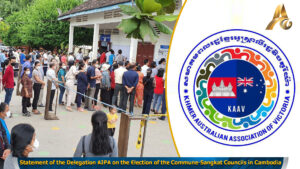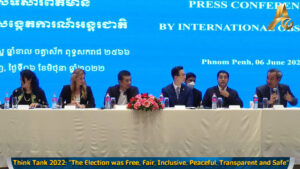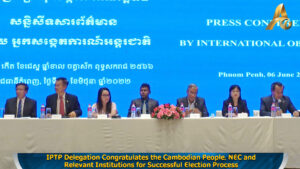Regional Free Trade Deals ‘Key to Cambodian and ASEAN Success’
Foreign investors and independent credit evaluators are echoing confidence in Cambodia in light of the series of free trade agreements (FTAs) both completed and being pursued by the Kingdom’s government. According to the ASEAN Briefing (AB), such FTAs could see the region become the world’s fourth-largest economy by 2030, comprising a consumer market estimated topping $4 trillion.
AB said that this economic achievement will be driven by four major forces. “Strong demographic trends, such as 65 percent of ASEAN’s population of 600 million moving into ‘middle-class’ status, the increase of foreign investment in the region, rising income levels and digital advances.”
However, the ASEAN website added that it is imperative for foreign investors to understand the regional FTAs in order to capitalise on the bloc’s long-term potential.
“International businesses can benefit from ASEAN’s FTA network in the form of reduced importer costs, improved custom clearances and increased access to products eligible for preferential treatment. Moreover, there are numerous tax and fiscal benefits such as tax holidays and deductions,” added AB.
The ASEAN-Australia-New Zealand Free Trade Area (AANZFTA) – agreed to in January 2010 and since updated – ensures tariff-free movement of 90 percent of goods traded between the signatories. It will encompass a trading population of approximately 653 million.
The ASEAN-India Trade in Goods Agreement was signed and entered into force in 2010 and marked the creation of one of the world’s largest free trade area zones, creating opportunities for more than 1.9 billion people in an area with a combined gross domestic product of $4.8 trillion.
That agreement set tariff liberalization for popular traded products such as palm oil, pepper, black tea and coffee and has seen exports to India from the ASEAN reaching some $55 billion.
Talks are ongoing to review the scope of the FTA to address existing issues within it regarding tariffs.
“India is treated differently than other ASEAN trade partners because it does not have an economic agreement with the bloc. For instance, Japanese car imports face a 5 percent duty in Indonesia and Thailand while a 35 percent tariff is imposed on Indian automobiles. There are opportunities in areas such as generic drug production and medical devices. India is the world’s largest provider of generic medicines and supplies some 62 percent of global vaccines,” AB said.
The ASEAN-Republic of Korea Free Trade Area came into force in 2007. Two-way trade reached $160 billion in 2019. Both signatories pledged to increase this to $200 billion during a summit in Busan to mark 30 years of ties. Greater economic ties with South Korea would help ASEAN diversify its economic interests, most particularly, away from an overwhelming reliance upon China as a market.
The ASEAN–Japan Comprehensive Economic Partnership came into force in December 2008. It was reviewed by both sides in 2020. The agreement saw two-way trade reach more than $214 billion in 2019
The review included dispute settlement mechanisms and rules on the movements of foreign business travellers. These rules are of particular importance to Myanmar, Laos and Cambodia, which are not currently in bilateral trade deals with Japan.
Recently trumped by the signing of the Regional Comprehensive Economic Partnership (RCEP), the ASEAN-China Free Trade Area dates from 2004. That FTA agreed to zero tariffs on more than 7,000 product categories from Indonesia, Malaysia, Singapore, Brunei, the Philippines, Singapore and Thailand in 2010, with the remaining states – Myanmar, Laos, Vietnam, and Cambodia – joining that group in 2015. In 2020, the ASEAN overtook the EU in becoming China’s largest trading partner, accounting for some 15 percent of China’s total trading volume at $140 billion.
“Electronics were the biggest contributor to this trade, with China importing $14.9 billion of integrated circuits, such as microprocessor chips, analogue-to-digital converters and chip capacitors from ASEAN countries. [However], ASEAN’s overtaking of the EU was largely the result of the EU having gone under extensive lockdown,” AB said, adding that may have been a contributing factor to the completion of the RCEP negotiations and its signing.
RCEP, the largest FTA in history, encompasses roughly 30 percent of the world’s population and 30 percent of global gross domestic product (GDP). “Some 65 percent of the service sector will be open to foreign investors, raising the ceiling for foreign ownership in various industries such as financial services, telecommunications, and professional services. The RCEP will also motivate investment through the China+1 strategy to lower-cost members of the FTA for countries including Cambodia, Myanmar, Indonesia and Vietnam for more labour-intensive processes, such as in garment manufacturing.”
The RCEP agreement will see tariffs removed on 92 percent of goods over the next 20 years, in a move that will require businesses to need only one certificate of origin for trading in the region. It is estimated to add some $186 billion to the global economy as well as 0.2 percent to the GDP of its members.
However, Minister of Commerce Penn Socivheat said he understands that both multilateral and bilateral agreements will be important to the Kingdom in the future. “The trend currently is starting to shift to the importance of bilateral relationships to tap the most benefits from targeted partners. It is about time that we consider catching opportunities to seize low-hanging fruit and reasonable offers from targeted markets like China and others. In the Cambodia Trade Integrated Strategy 2019-2023, FTAs are prioritised targets. We feel that it is necessary to exchange the lowering and eliminating of tariff and non-tariff measures for gaining additional market access for our goods and services as well as the attraction of more investment to increase employment opportunity and new technologies.”
He said in a world hit hard by the pandemic, recovery to normality will be achieved through multilateral trading systems or bilateral relationships such as FTAs. “As they come into effect it will help us open market access, increase trade volumes, services and the inflow of foreign investment.”







